Death Note
- Year
- 2006
- Original title
- Desunoto
- Japanese title
- デスノート
- Director
- Cast
- Running time
- 126 minutes
- Published
- 9 August 2013
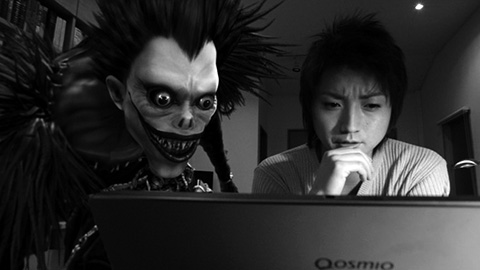
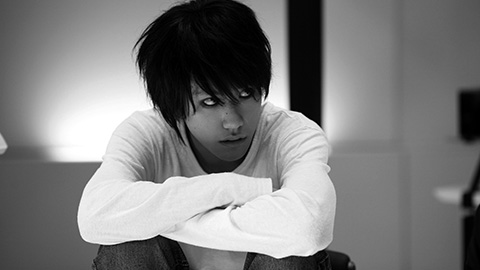
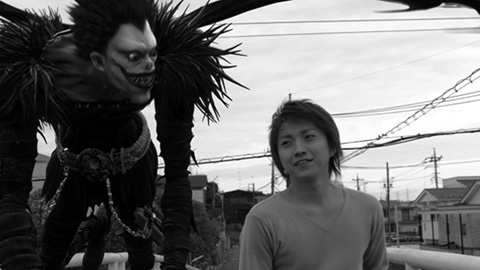
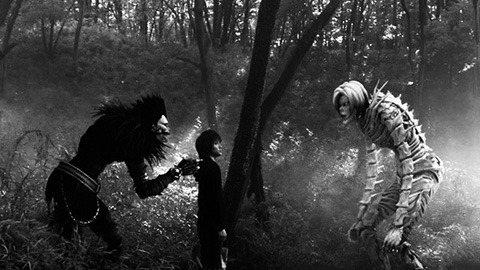
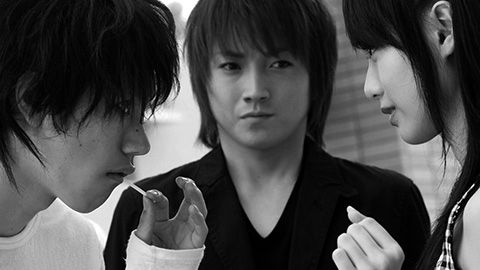
by Tom Mes
Brilliant Tokyo law student Light Yagami (Fujiwara) grows disillusioned with the judicial system after he learns how many criminals are let off the hook on an annual basis. Literally out of nowhere, the solution to his dilemma lands at his feet: it is the Death Note, a notebook that has the power to kill off any person whose name is jotted down in its pages.
Light tries his hand by eliminating a series of rapists and murderers that managed to avoid prosecution, all of whom die of sudden heart failure seconds after Light has written down their names. Flushed with his success and the enthusiastic support of the notebook’s original owner, the death god Ryuk, Light decides to rid the world of its criminals. The deaths, though all ostensibly brought on by cardiac arrest, draw the attention of the police, who set up a task force headed by Light’s police inspector father. Popular support for the killings grows, as chat rooms and media buzz with debate over the unknown righteous avenger who calls himself Kira.
With the help of an enigmatic genius known only as L, the police slowly tighten the net around the culprit, finding in Light Yagami the ideal suspect. As he is pushed into a corner, Light becomes increasingly erratic and starts to use the Death Note to take out all those who stand in his way. First the young FBI agent that has been shadowing him drops dead on a subway platform, but soon even his loved ones are no longer safe from Light’s powers. Having found that he can manipulate the times and causes of his victims’ deaths, he engineers a confrontation in which he sacrifices the life of his girlfriend in order to clear himself of all suspicion. The plan works and Light asks his father if he can help the police in hunting down Kira. L, revealed to be a young man of Light’s age and intelligence (though with an added penchant for eyeliner), continues to suspect him.
Death Note exemplifies a form of mainstream Japanese cinema of which we Westerners normally get to see little, as few distributors have dared venture very far outside the familiar markets of art house film and genre fare that, during the DVD era, became the dominant pegs from which to dangle anything Japanese. This is not necessarily a bad thing, as Japanese mainstream fare, even when it is based on a Yukio Mishima novel or an Akira Kurosawa classic, tends to be on the melodramatic and hackneyed side. It is to all intents and purposes an extension of daytime television fodder, not surprising given the heavy involvement of broadcasters in their financing.
In the meantime, however, Japan’s pop culture has found a new audience on these shores in the otaku, rabid fans of manga and anime, who very often are unaware that there is such a thing as a Japanese cinema proper – unless it is adapted from manga. That they have a bit of money to burn is proven by the sales figures of the comic books and the attendance figures at otaku conventions.
This must be what convinced its Western distributors that Death Note would form a worthwhile investment and give it an uncharaterictically wide dissemination for a film of this kind: its format of a police procedural with mild fantastical overtones hardly fits either aforementioned market. Despite the murderous goings-on and the appearance of a creature from hell, this is far from the dark realms of J-horror – most of the original manga’s more horrific elements have in fact been toned down for safe consumption by young teens and housewives alike. Not surprisingly, TV is to blame here too, what with Nippon Television, one of Japan’s major broadcast networks, being at the film’s origins.
Former monster film specialist Shusuke Kaneko gives the film a surface gloss of CGI, moving cameras and moody lighting, but his efforts can’t hide the fact that the cliffhanger-based structure of TV scribe Takeshi Oishi’s script, the fresh-faced young leads and the overacting veterans (Takeshi Kaga as Light’s father is a particular offender) are straight off the small-screen production line.
Everything about Death Note is two-dimensional, from the silly CGI creation Ryuk (who looks like Heath Ledger’s Joker after a Shibuya makeover) to the hero’s picture perfect home situation – the straight-laced detective and his model housewife are a conservative politician’s wet dream of responsible citizenry. Kaneko was probably too busy planning helicopter shots to give much thought to his characters, which leaves one to wonder what sort of subversive gold broken-homes specialists like Takashi Miike or Kiyoshi Kurosawa might have mined from the same material. A glance at Tatsuya Fujiwara's role as another remorseless killer in Miike's later The Shield of Straw (Wara no Tate, 2013) will reveal the many shades of grey a different director can bring to the same actor playing a similar character (one that arguably held more likelihood for two-dimensional portrayal than Light Yagami).
Much the same goes for the discussion over the value of human life that forms the film’s premise. We have seen these kinds of talking-point issues in popular Japanese entertainment before, notably in Kinji Fukasaku’s notorious Battle Royale (2000). For all its flaws, Fukasaku’s film at least kept its what-if scenario firmly rooted in contemporary socio-political soil. Death Note may share Battle Royale’s lead actor Tatsuya Fujiwara, it does not share its relevance. The central debate here is barely veiled demagoguery, with every suspect or criminal that succumbs to Kira’s might portrayed as a twitchy, giggling sociopath who delights in doing evil. So much for the presumption of innocence – or the presumption of intelligence on the part of the audience. Tellingly, the issue is swiftly swept under the carpet in favour of black-and-white characters doing either good or evil. Nothing is done with the potential for ambiguity in Light Yagami, a young man suddenly given the responsibility of deciding over life and death. He lets the power of the death note go to his head well before the end credits roll, leaving little for part two, Death Note: The Last Name, but intrigue and increasingly spectacular action set pieces. The golden boy degenerates into the cackling, megalomaniacal schemer of a thousand B-movies, but of course he remains soooo handsome. And that pretty much sums up the scope of Death Note’s ambition.